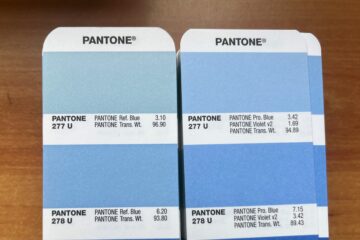In this busy world of ours, sometimes having the initial conversation between printer and designer is not always a possibility. However, in order to avoid mistakes at the end of the project, these critical conversations must take place to set the expectations for all parties.
Since printing is, in essence, a custom manufacturing of a work of art, it’s worth the time for both the printer and designer to have early and open dialogue about the role that paper will play. Paper affects the final appearance of the design, the tactile experience of the recipient and the satisfaction of the customer.
Here is of the top 5 critical conversations that should take place early in a print project between printers and print buyers:
- Some basic paper terminology might be a good place to start especially when working with a less experienced print buyer. Caliper, for example, refers to the thickness of the paper. The caliper of paper is the most important aspect to consider when designing a stand-alone mailer.Postcards that are 3.5 x 5 (minimum size to meet USPS spec) must be a minimum of 7pt caliper. If the postcard is larger than a max size of 25” high x 6” long, the paper must be at least 9pt. For this specific end use, the client must select a paper that will meet these caliper minimums to avoid rejection at the Post Office or pay a surcharge in postage. Caliper might also factor in on jobs where postal considerations are not a factor.Extremely thin or thick paper can slow the print production time or even prohibit some finishing techniques that the client desires. Some paper stocks are too heavy to score and fold. Other heavy stocks can slow the scoring and folding time, which adds costs to the job. It’s best for the end user to know of these factors while still in design mode.
- Another factor to consider is job layout. Good friend and experienced print sales rep, Dave Rittman, of Color FX in Iowa, shared some discussion points on job layout that he talks through with clients. When books, manuals or other multiple page brochures are the end game, it is wise to discuss the finished number of pages.An explanation of how the job prints can allow the design to fit the most efficient multiple of pages vs. an exact page count. If the finish page size is 8 ½ x 11 and will be printed on a full-size sheet press, the end user should layout the work with multiples of 4, 8, or 16 pages. The most efficient (least amount of waste) of these options is a 16-page signature.Another common booklet size – Digest, is 5 ½ x 8 ½. The client should calculate these pages in increments of 8, 16, or 32, with 32 being the most efficient. Any page count outside of those multiples will result in waste.
- When a full-size sheet will be passing through the press, you might as well put ink on all of it to maximize the efficiency of the sheet. While there are typically some up-charges for heavy coverage vs. light coverage, you are typically paying for the impression on the press, whether the whole full sheet is covered with ink or not.
- The weight of the paper will affect the weight of the finished print product and therefore affect the postage, if mailing, or the freight costs if the product is shipping from the plant.
- Make sure that the designer has factored paper with enough opacity to limit show through from one side of the sheet to the other. As the weight of the paper goes up within a grade of paper, the opacity goes up as well. The increased weight helps minimize show through but will potentially increase shipping and postal costs. If needed, the local paper merchant can provide samples of the various papers that need to be considered. Some of them will even produce an unprinted mock up that can be weighed. This service can allow a print sales rep to share potential effect on costs to ship the finished product.
For designers, the best advice is to bring your print rep into these critical conversations early to maximize efficiency of your creative time. For printers, ask the right questions to get designers to share the details of the job so you can provide most efficient option in their design and for your pressroom

